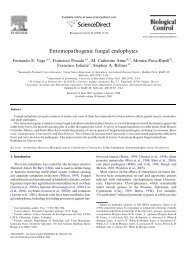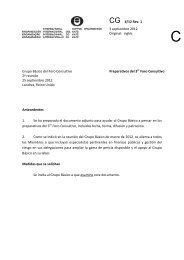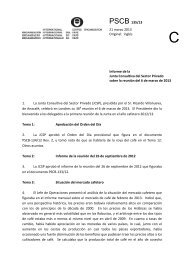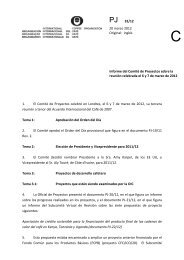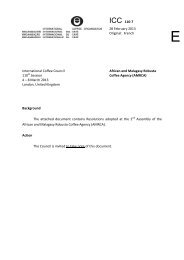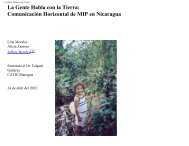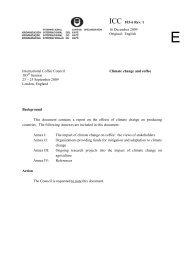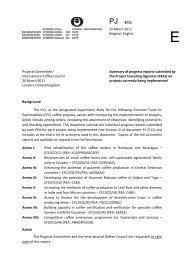Devouring profit - International Coffee Organization
Devouring profit - International Coffee Organization
Devouring profit - International Coffee Organization
Create successful ePaper yourself
Turn your PDF publications into a flip-book with our unique Google optimized e-Paper software.
Hence a contracted temporary worker could expect an annual income of around US$250<br />
if he works all the year. In comparison to many countries labour is therefore very<br />
Table 33. Labour wages in different states of India, 2000 prices.<br />
State Rs/day US$/day<br />
Karnataka 56.25 1.25<br />
Kerala 71.74 1.59<br />
Tamil Nadu 46.50 1.03<br />
Andhra Pradesh 61.70 1.37<br />
cheap in India, and explains why labour is a smaller proportion of the total production<br />
cost structure than other countries. IPM strategies often demand greater amounts of<br />
labour than other methods (e.g. a calendar spray regime for instance) hence the low<br />
cost of the labour in this country could facilitate the adoption of IPM strategy for<br />
managing CBB.<br />
Farmers’ income: income from coffee is very seasonal in India, with just one peak of<br />
income per year, which can be worrying for the farmer. In order to minimise the effect<br />
of seasonal variations, farmers may be expected to try to spread flows of labour and<br />
harvest production throughout the year. Upton (1996) points out that there are various<br />
strategies, such as diversification of agricultural production, to establish different onand<br />
off-farm activities, storing food, seeds and animal fodder, etc. Seasonal income<br />
will have different effects depending on the period of the year when income is scarce<br />
because some activities have to be delayed to attend to a more important activity. The<br />
farmer has to manage different labour requirements and availability to optimise his<br />
gross income. In the case of CBB management, practices that can easily be accommodated<br />
by the farmer will be more easily accepted by him.<br />
In order to diversify their income, Indian coffee farmers have developed production<br />
systems to involve more than one crop in order to get income from different sources<br />
and in different periods of the year. In a project survey carried out on coffee farmers of<br />
Karnataka it was found that 95.6% of them had pepper as an inter-crop. In many cases<br />
the inter-crop allows generation of an important part of the total farm income. For<br />
instance in an interview carried out during the visit to Wayanad region we met Mr.<br />
Vijayakumar who has a small farm of about 1 ha. He told us that his income was<br />
depending on three sources,- coffee, pepper and areca nut. The individual participation<br />
of each of them to his income was coffee, 50%; areca, 29%; pepper, 21%.<br />
Thus other crops are important to the income composition of a normal coffee farm. It<br />
is quite possible that sometimes this alternative income becomes a relevant source to<br />
cover costs related to CBB management, whilst at others it could become a source of<br />
competition for the farmer’s resources.<br />
23 Exchange Rate US$1= Rs 45<br />
23<br />
87




